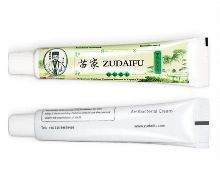

Effective Skin Psoriasis Cream - Dermatitis Eczematoid Eczema Treatment (15g)
$24.00
Retail Price:$35.00
You Save: $11.00 (31%)
$24.00
Retail Price:
You Save: $11.00 (31%)
Psoriasis - Skin disease
Psoriasis is a very common, genetically conditioned, skin disease in the formation of which unknown and various provoking factors are involved - psychological trauma, infection or medication. The type of inheritance of the disease is not fully understood, it is assumed that the person must be phenotypically predisposed. About 3% of the population suffers from psoriasis and as many good therapies for this disease exist, patients are most often dissatisfied with the aesthetic impact of the disease on their lives.
How does the disease manifest itself?
Psoriasis can manifest with only a few changes in the size of the coin, with thickened, red skin covered with whitish thick flakes. Most often on the elbows and knees, ie the outer sides of the extremities. It can also be accompanied by frequent itching, but with a smaller percentage of patients. Contrary to this description, plaques appear on some individuals throughout the surface of the body, face, pelvis, sometimes accompanied by sterile slurries. Psoriasis can even affect the surface of the entire body (erythroderma) when the patient is at risk of life. It is an immune inflammatory process of the skin that is not infectious and if it can sometimes be provoked by bacterial foci in the body. In 40% of patients, joints can also be affected.
There are huge variations in the appearance and dynamics of the onset of the disease. The mechanism of skin changes is accelerated cell division, with a large number of T lymphocytes accumulating. Triggers are external factors, most commonly trauma either in terms of viral disease, bacterial infection (streptococcal sore throat), or emotional stress. Within 2 to 6 weeks, the first changes corresponding to psoriasis occur. Drugs, alcohol and cigarettes provoke a worsening course of the disease. Sea water and moderate sunshine have a beneficial effect on this disease. However, burning in the sun often means extensive and new changes in the disease.
How is psoriasis treated?
The therapeutic approach must be different for each patient depending on the form and prevalence of the disease. Corticosteroid creams, with or without salicylic acid, are most often the first line of therapy for mild and localized psoriasis, especially on the extremities and the genitals. Applying the drug under plain foil significantly enhances its effect. Often corticosteroid creams are combined with creams containing Vitamin D3 (calcipotriol) or synthetic vitamin A (tazarotene). The long and successfully used tar products are most commonly used to the lesser success of the above mentioned subjects. In the treatment of extensive forms of psoriasis and forms of psoriasis followed by inflammation of the joints, drugs belonging to the group Cytostatics (Metotrexat) are used, but which are given in such small doses as to have an immunomodulatory effect - not cytostatic. Isomers of synthetic vitamin A - acitretins, are recommended for psoriasis of palms and soles followed by pus.
UVA and UVB radiation are very successful in the treatment of psoriasis, with or without the addition of substances that more intensely bind UV rays - psoralen. This type of therapy has benefited from the beneficial effects of sunlight on people with psoriasis. Mineral seawater and sunlight (UV radiation) result in the withdrawal of mild psoriasis. UVA and UVB radiation have an immunomodulatory effect on the skin, which reduces the amount of T lymphocytes in the skin. With this effect, psoriatic seals resulting from the multiplication of skin cells and the accumulation of white blood cells and mediators of inflammation are also reduced. Because skin immunity is lowered from other harmful factors at the same time, patients are advised to take dosed sun exposure, always with a protective factor of 20 or 30. Biological treatment is a new type of therapy that primarily affects T lymphocytes. The treatments are extremely expensive and are the choice for patients who have psoriatic arthritis - joint inflammation or some contraindication for the types of therapies listed so far.
It should not be lost sight that any damage to the skin can lead to new changes.
Although there are a wide variety of ways to treat psoriasis, almost 40% of patients are dissatisfied, most often because of their inability to cure the disease permanently as well as continued use of therapy.
Skin Psoriasis Cream - a prophylactic for the skin. For external use only.
Purpose: It has a keratological, anti-inflammatory and regenerative effect.
Component properties: The fat components act as a focal point for inflammation, carefully cleansing the top layer of skin from the arm cells, ensuring the high availability of bioactive agents. They contribute to the rapid restoration of overall skin integrity.
Application: Psoriasis, eczema, neurodermatitis, atopic and allergic dermatitis.
Contraindications: Not detected, individual intolerance to components is possible.
Usage and dosage :
External use, apply this product rub skin infections.
1. the skin: apply wash affected area, 2 to 3 times a day:
2. vaginal: apply this product about 3 g into the vagina cha: daub vulva at the same time, 1-2 times a day:
3. the anus: wash affected area with the warm boiling water, apply this product about 3 g directly or injection piles affected area.
Side effects: A slight worsening of the disease at the beginning of administration is possible.
Form in which it is placed on the market: 15g tube.
Storage conditions: Store at room temperature, out of reach of children.
Package: 1*1 x Psoriasis Ointment, without box
